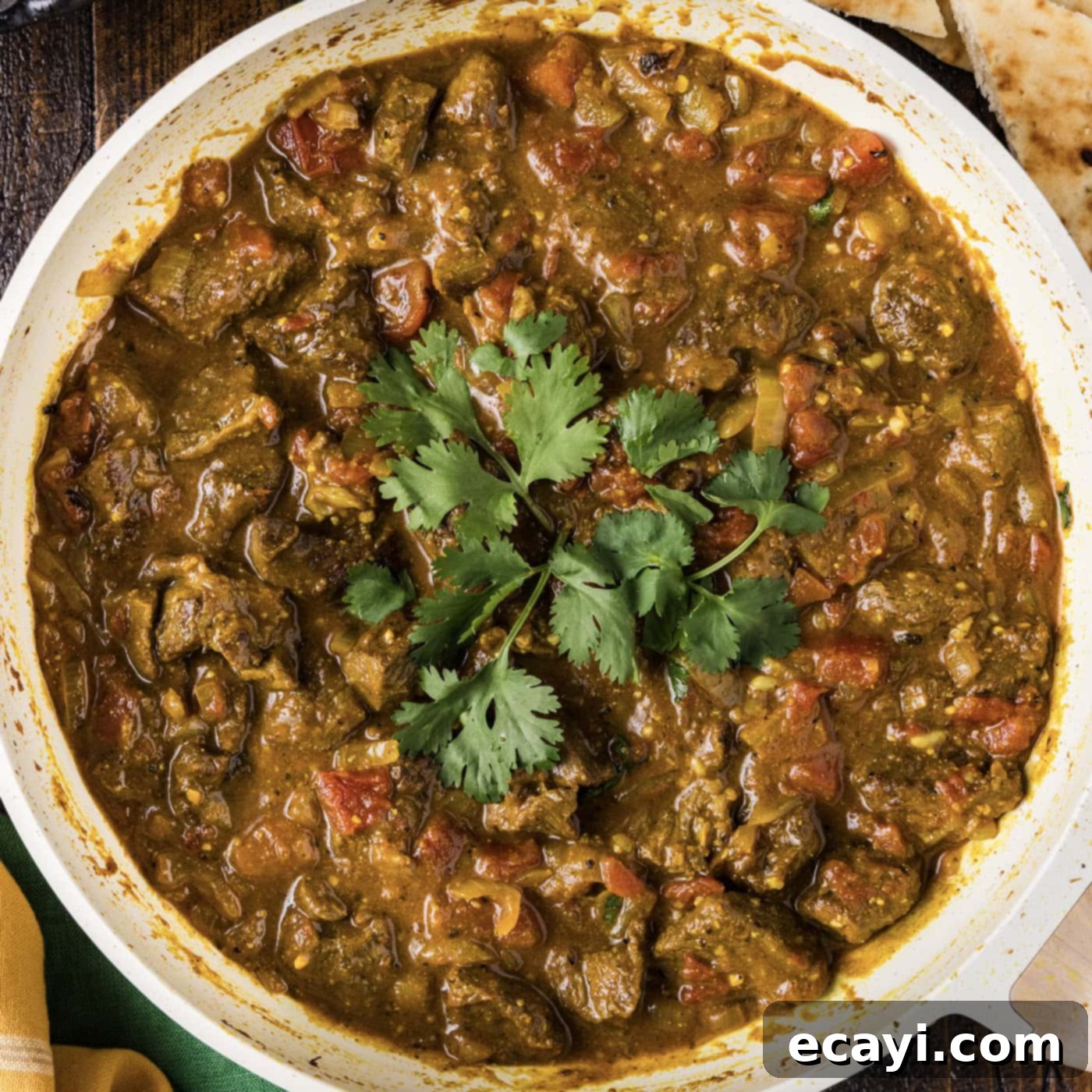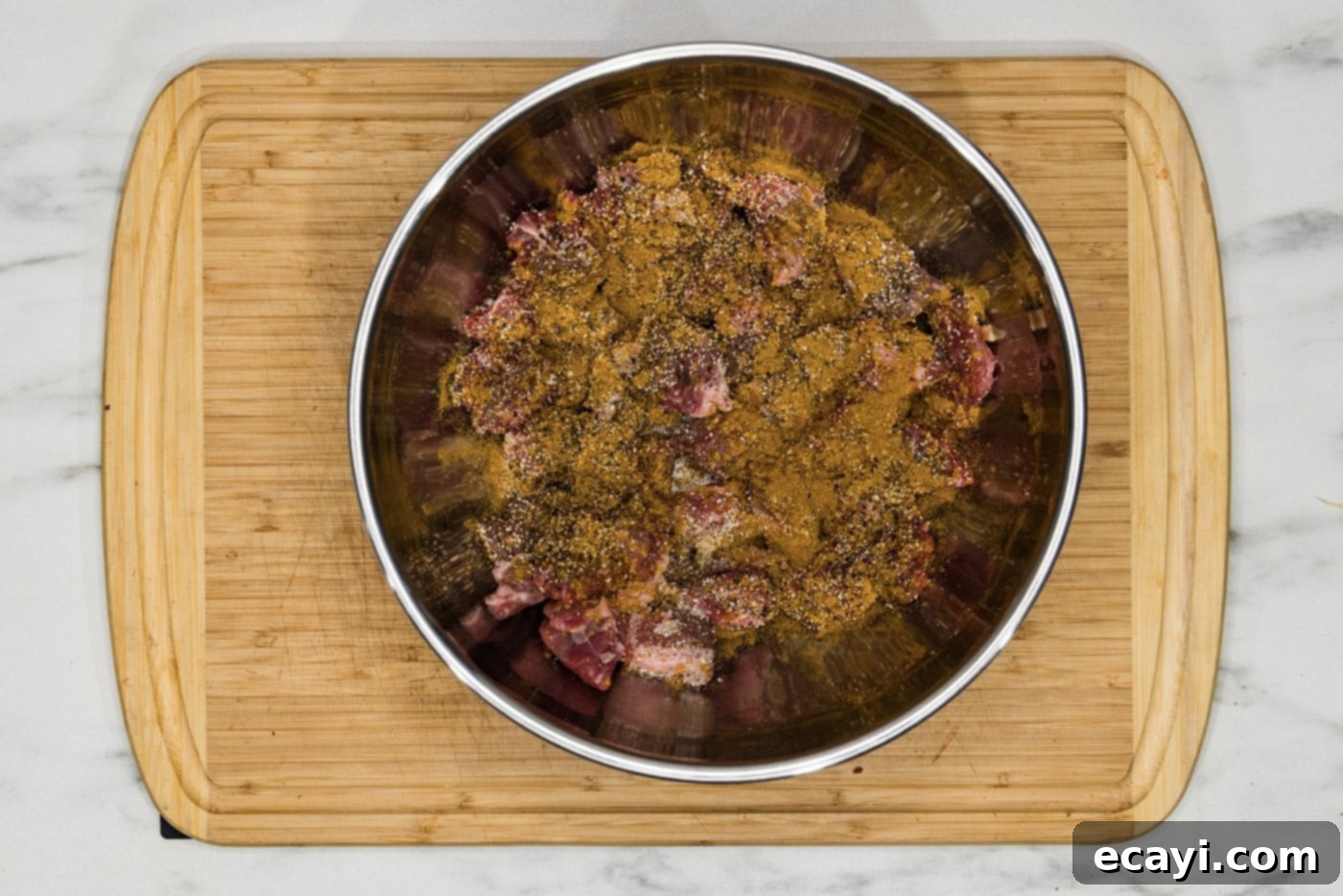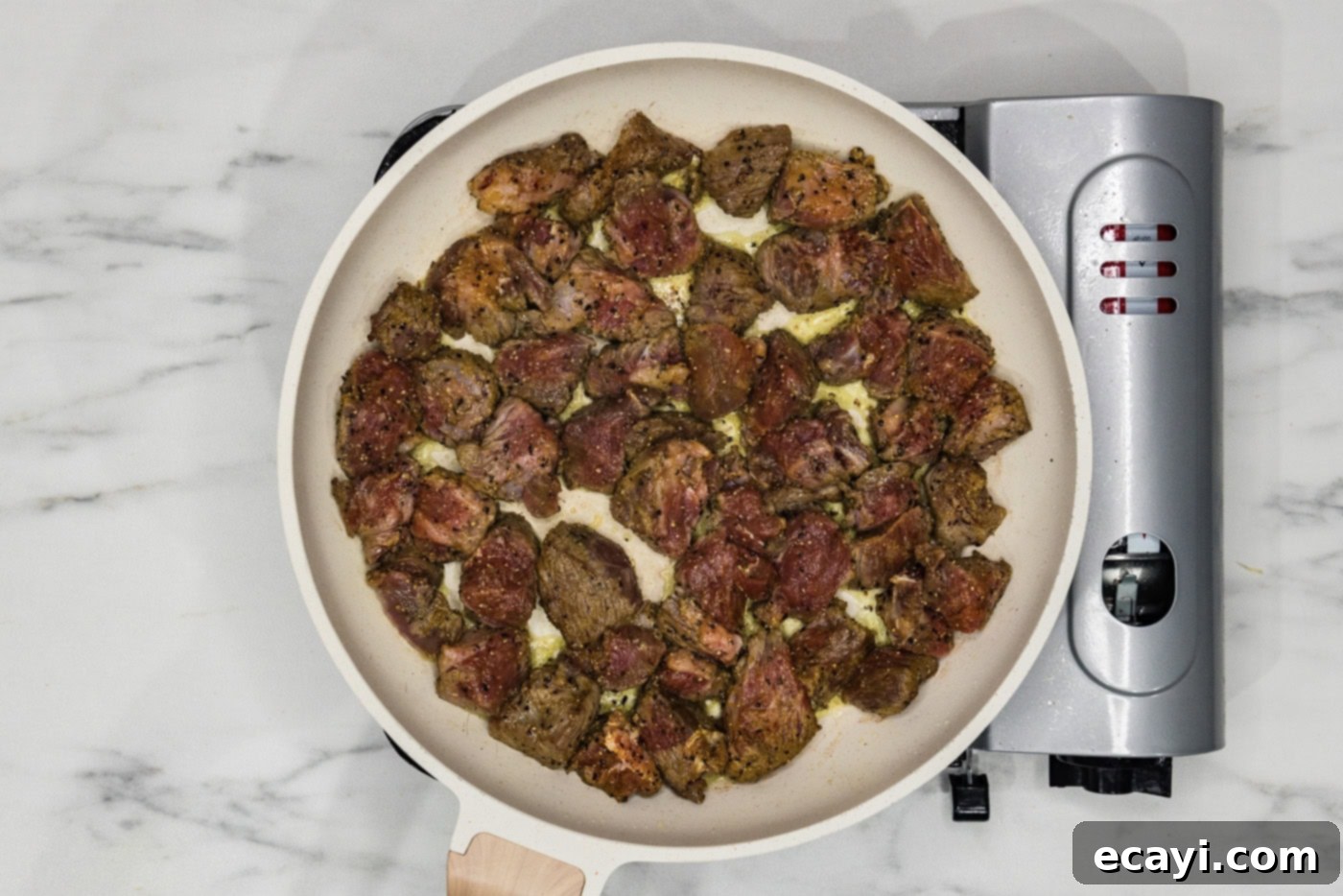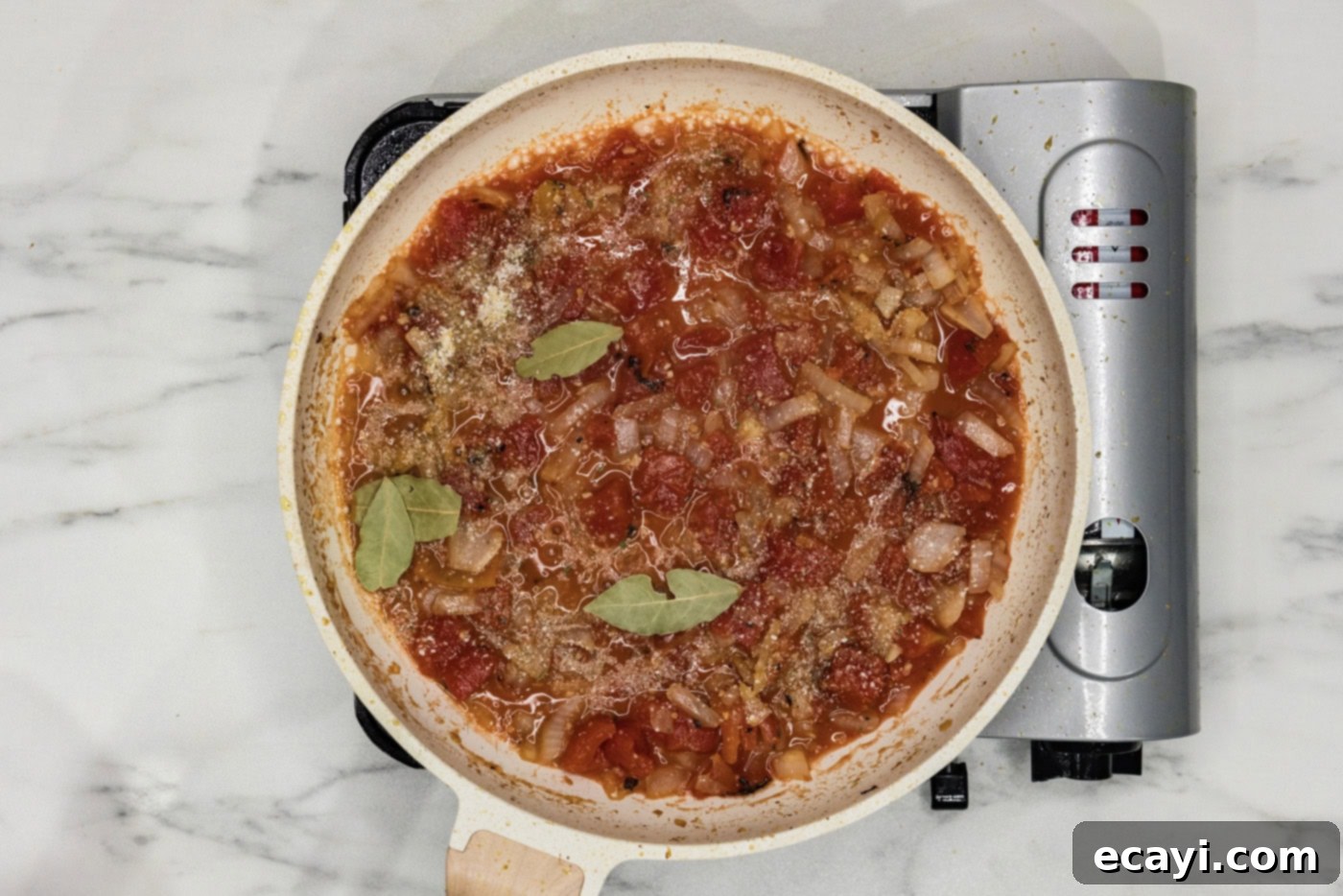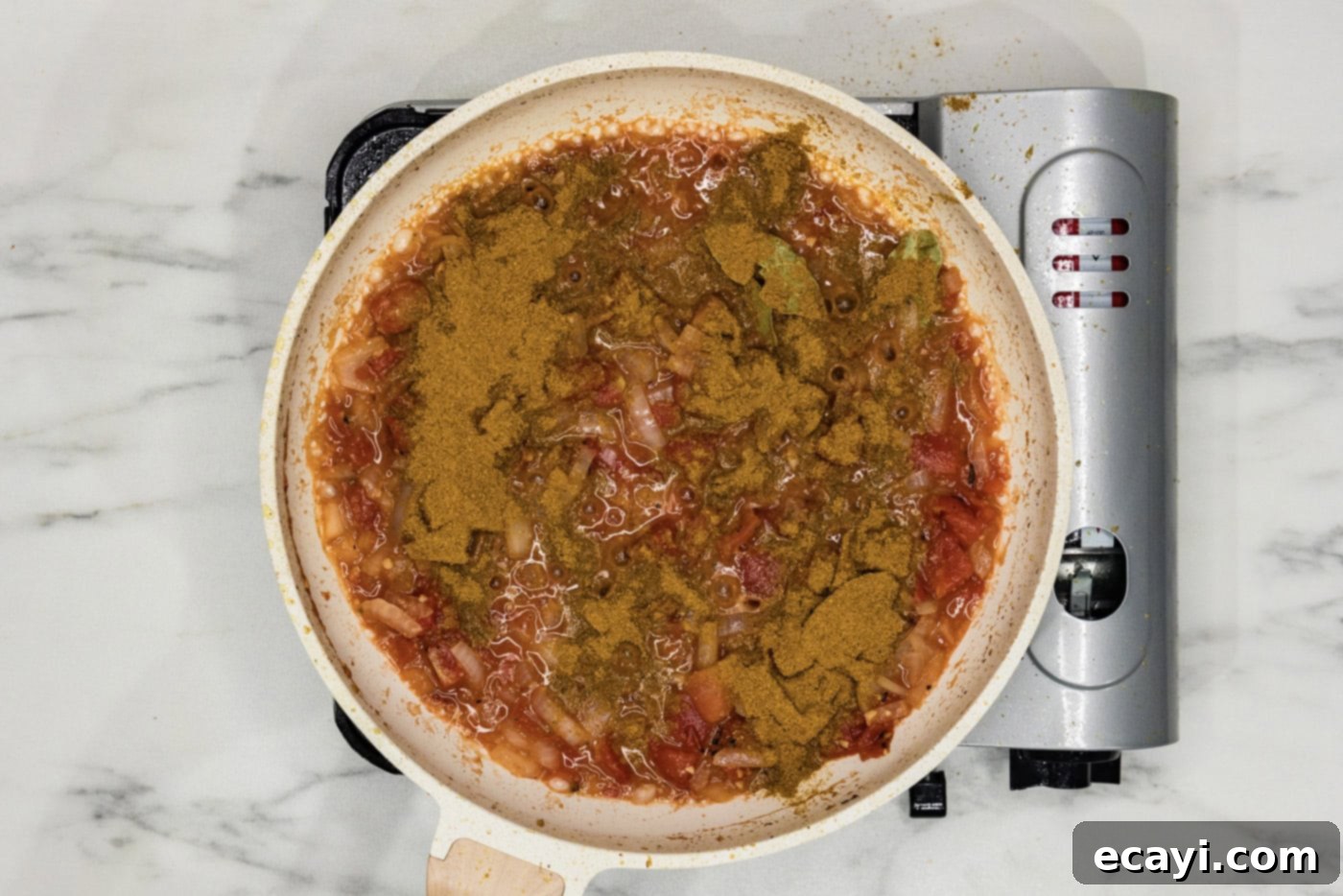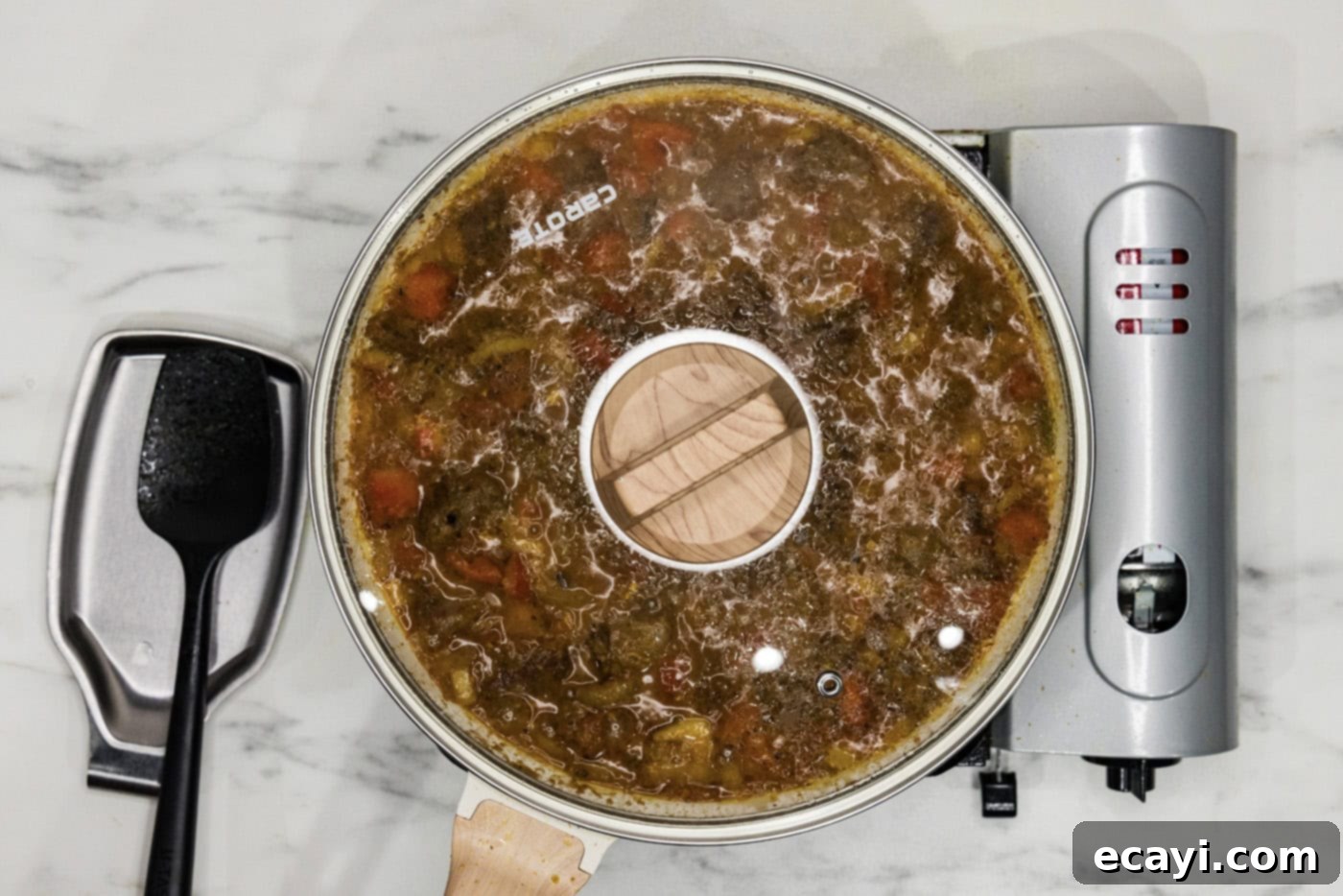Easy Stovetop Beef Curry: A Rich, Tender, and Flavorful Homemade Recipe
Transform your dinner routine with this incredible, easy beef curry recipe, meticulously crafted right on your stovetop. This dish is a celebration of rich, warm flavors, where tender chunks of beef are slow-simmered in an aromatic sauce featuring ginger, garlic, bright tomatoes, and a delightful hint of dry white wine. It’s a comforting, hearty meal that promises a depth of flavor usually associated with hours of preparation, yet remains surprisingly straightforward to make. Perfect for a cozy family dinner or entertaining guests, this beef curry will become a staple in your kitchen, begging to be served with steamy rice or warm flatbread.
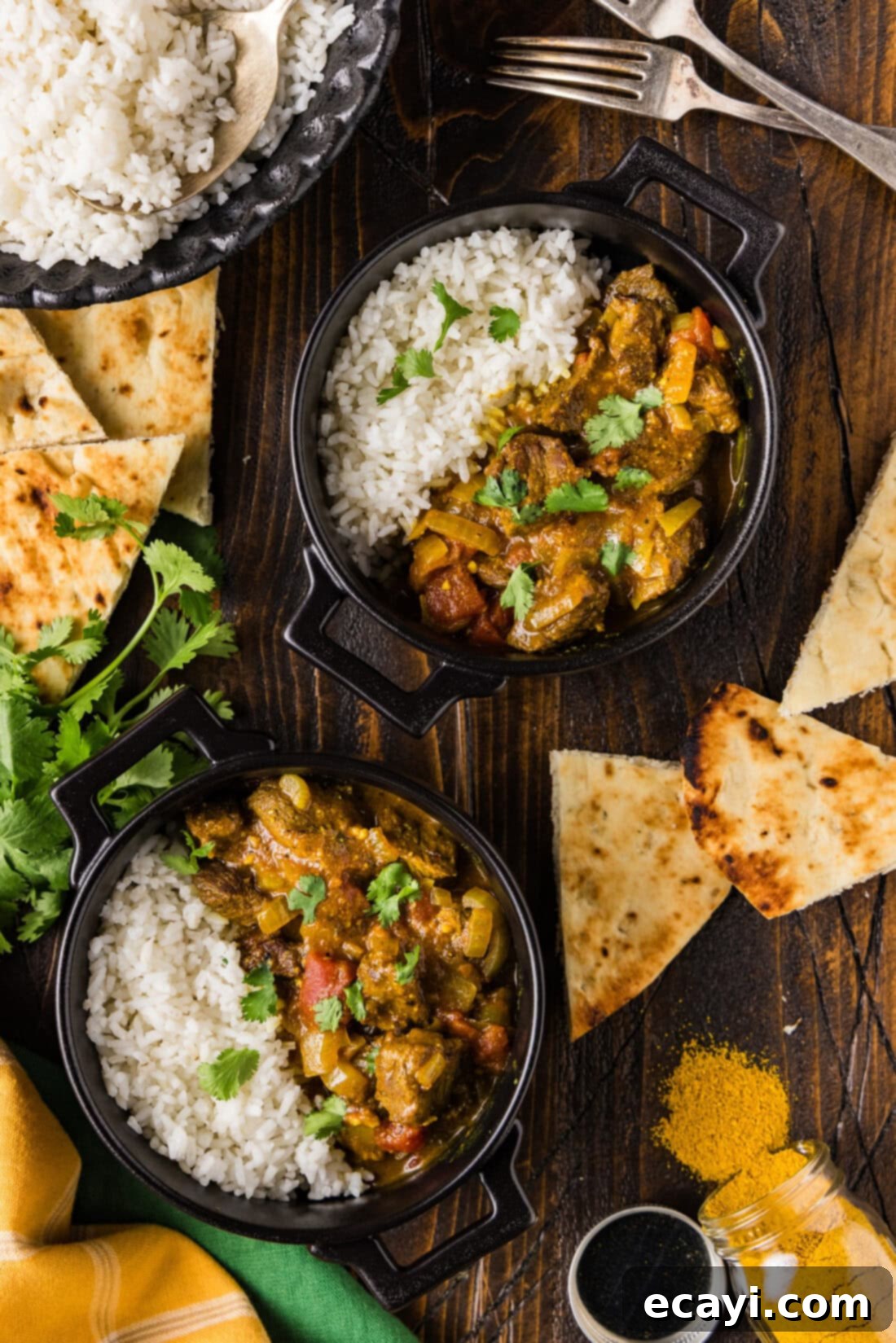
Why This Easy Stovetop Beef Curry Recipe Works So Well
This beef curry is more than just a meal; it’s a deeply satisfying culinary experience. Its success lies in the perfect marriage of tender beef and an incredibly flavorful sauce, brimming with bold aromatics and spices. We start with robust beef chuck roast, allowing it to slowly braise until it reaches an irresistible, melt-in-your-mouth tenderness. As the beef simmers, it absorbs the vibrant essence of fresh garlic and ginger, along with the complex warmth of a well-balanced curry powder blend.
What sets our beef curry apart from many traditional versions is its unique base. Instead of relying on coconut milk for creaminess, this recipe uses a tomato and white wine foundation. This combination offers a delightful acidity that brightens the rich flavors, adds depth, and creates a lighter yet equally comforting sauce. The process is designed to be simple and accessible, making it an ideal choice for both seasoned home cooks and those new to curry. You’ll find that the flavors develop beautifully on the stovetop, making it an efficient and delicious way to achieve a truly authentic and heartwarming curry. It’s a dish that truly shines, practically inviting a generous spoonful of its savory goodness over a bed of fluffy white rice.
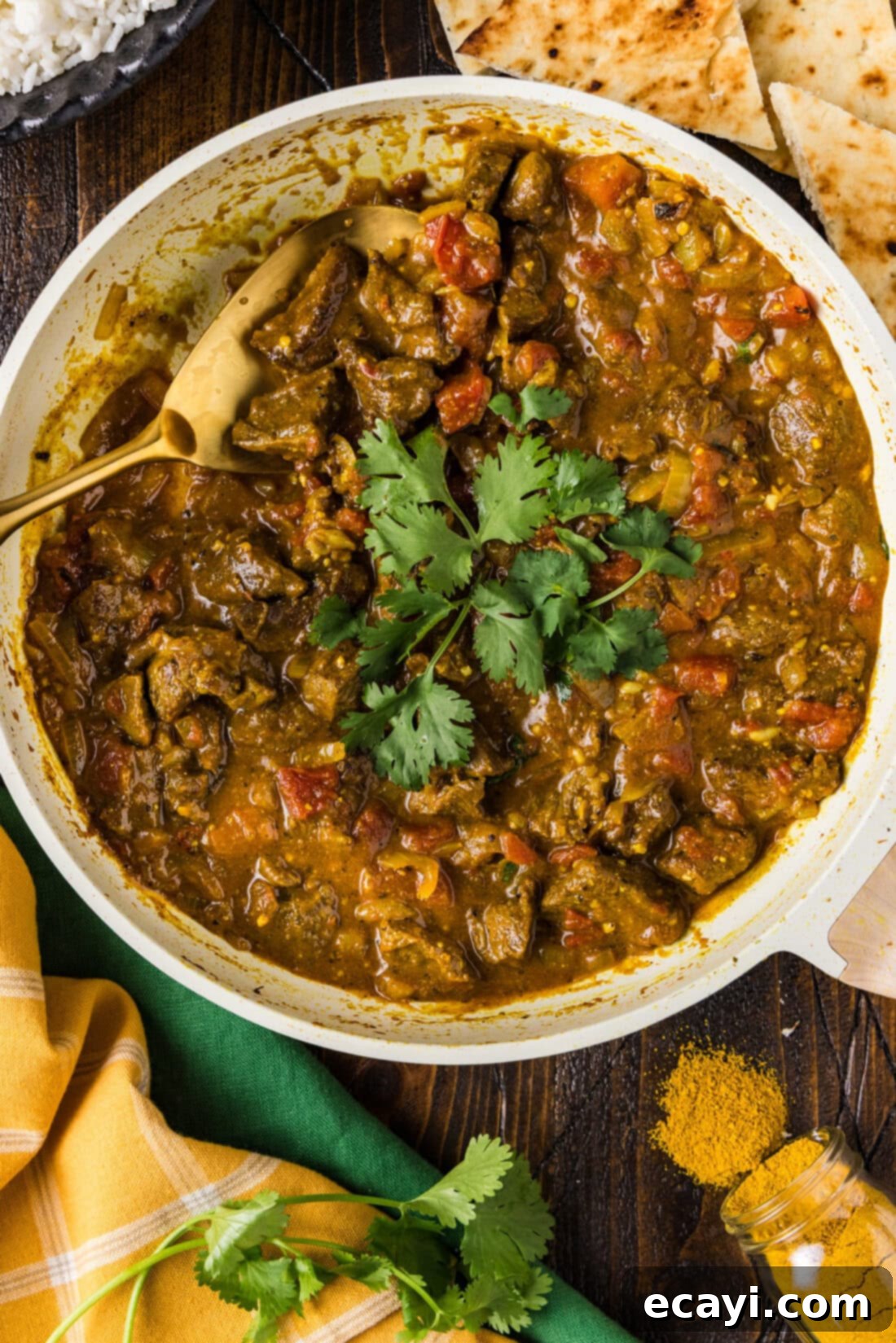
Essential Ingredients for Your Delicious Stovetop Beef Curry
Crafting this flavorful beef curry begins with selecting quality ingredients that contribute to its rich profile. Below, you’ll find an overview of the key components. For precise measurements and step-by-step instructions, please refer to the complete printable recipe card at the very end of this post.
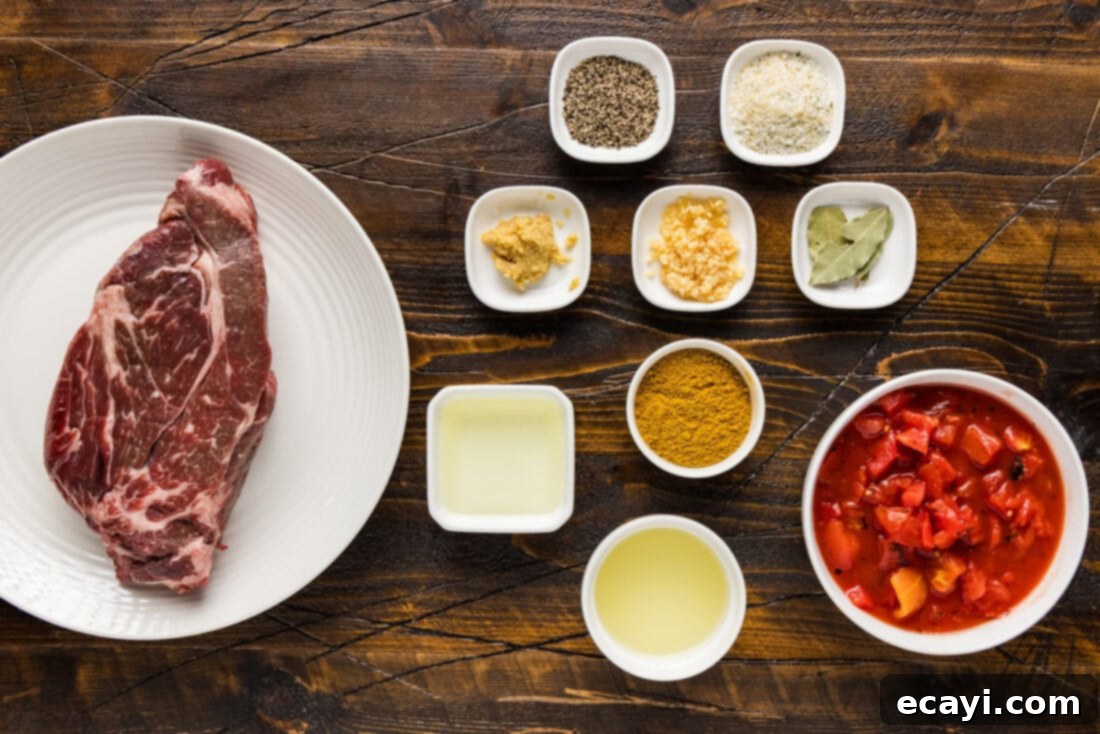
Ingredient Spotlight & Smart Substitution Suggestions
Understanding the role of each ingredient and knowing your options for substitution can greatly enhance your cooking flexibility and ensure a successful dish every time.
BEEF – For the best results in terms of flavor and tenderness, we highly recommend using beef chuck roast. This cut is perfect for slow simmering as its marbling renders down, enriching the sauce and yielding incredibly tender, flavorful meat. If chuck roast isn’t available, you can substitute it with pre-cut beef stew meat. However, be prepared that stew meat might require a slightly longer cooking time to achieve the same level of tenderness. Always trim any excess fat from the beef for a cleaner, richer flavor in your curry.
WHITE WINE – Dry white wine is a key component in this beef curry, contributing a beautiful depth and a sharp, acidic note that beautifully balances the richness of the beef and spices. It also helps deglaze the pan, capturing all the browned bits that are packed with flavor from searing the beef. Excellent choices for cooking include Sauvignon Blanc, Pinot Grigio, or an unoaked Chardonnay. There’s no need to use an expensive bottle; just pick one you enjoy the taste of. If you prefer a non-alcoholic option or don’t have wine on hand, you can substitute it with an equal amount of good quality beef broth or vegetable stock. To replicate the crucial acidity that wine provides, we highly recommend adding 1-2 teaspoons of **white wine vinegar or fresh lemon juice** when using broth, though this step is optional but recommended for balanced flavor.
TOMATOES – Canned tomatoes form the heart of our curry sauce, providing a natural sweetness and tangy base. We particularly love using fire-roasted canned tomatoes for their subtle smoky undertones, which add another layer of complexity to the overall warm flavor profile. If fire-roasted aren’t available, regular diced or crushed canned tomatoes will also work perfectly well.
AROMATICS (GINGER, GARLIC, ONIONS) – Freshly minced ginger, garlic, and finely chopped onions are absolutely essential for building the foundational aromatic layer of this curry. Their fragrant essence permeates the entire dish, creating a robust and inviting aroma. Using fresh ingredients here will yield a significantly superior flavor compared to powdered alternatives.
CURRY POWDER – This is the spice blend that gives the beef curry its characteristic warm and complex flavor. Curry powders can vary significantly in their spice blend and heat level from brand to brand. Feel free to adjust the amount used based on your personal preference for intensity and spiciness. If you enjoy a spicier curry, a pinch of cayenne pepper or a few chili flakes can be added along with the curry powder.
BAY LEAVES – These simple leaves contribute a subtle, earthy, and slightly herbaceous aroma to the sauce as it simmers, enhancing the overall depth and complexity of the curry.
Crafting Your Delicious Stovetop Beef Curry: Step-by-Step Guide
These step-by-step photos and detailed instructions are here to help you visualize how to make this incredibly flavorful beef curry. For a complete printable version of this recipe, including all measurements and comprehensive instructions, you can easily Jump to Recipe at the bottom of this post.
- Prepare the Beef: Start by carefully trimming any excess fat from your beef chuck roast. Once trimmed, cut the beef into uniform, bite-sized cubes, ideally about 1 to 1.5 inches in size. Consistent sizing ensures the beef cooks evenly. Place the cubed beef into a large mixing bowl.
- Season the Meat: Generously season the beef cubes with black pepper, half of the garlic salt (¾ teaspoon), and half of the curry powder (1 Tablespoon). Using gloved hands (or thoroughly clean hands), toss and massage the seasonings into the beef until every piece is well-coated. This initial seasoning is crucial for building layers of flavor from the very beginning of the cooking process.

- Heat the Oil: Heat ¼ cup of olive oil in a large, heavy-bottomed skillet (or a Dutch oven) over medium-high heat. The oil should be shimmering and hot, but not smoking, indicating it’s ready for searing.
- Sear the Beef: Carefully add the seasoned beef cubes to the hot skillet in a single layer. Avoid overcrowding the pan; if necessary, sear in batches to ensure proper browning and a delicious crust. Cook for about 2 minutes undisturbed to allow a beautiful sear to form, then turn the beef over and cook for another minute or so until browned on all sides. Remove the seared beef from the skillet and transfer it to a separate bowl, keeping it warm and reserving any juices that collect.

- Sauté the Aromatics: Reduce the heat to medium. To the same skillet (there’s no need to clean it; those browned bits add incredible flavor!), add the 2 teaspoons of minced ginger, 1 Tablespoon of minced garlic, and 1 cup of chopped onions. Sauté, stirring frequently, until the onions become translucent and tender, which typically takes 2-3 minutes. This step creates the aromatic backbone of your curry.
- Build the Flavorful Sauce: Pour in ¼ cup of dry white wine, using it to deglaze the pan. Scrape up any delicious browned bits from the bottom of the skillet, as these are packed with flavor. Add 14 ounces of canned tomatoes (fire-roasted if preferred), the remaining ¾ teaspoon of garlic salt, 3 bay leaves, the remaining 1 Tablespoon of curry powder, and ½ cup of water. Stir all the ingredients thoroughly to combine them into a fragrant, vibrant sauce.


- Combine and Bring to a Boil: Return the reserved seared beef and any accumulated juices from its bowl back into the skillet with the newly formed sauce. Stir everything well to ensure the beef is submerged and thoroughly coated. Increase the heat slightly and bring the entire mixture to a gentle boil.
- Simmer to Perfection: Once the curry is boiling, reduce the heat to low, cover the pan tightly with a lid, and let it simmer gently for 20-25 minutes, or until the beef is wonderfully tender and can be easily pierced with a fork. The longer it simmers on low heat, the more the flavors will meld and the beef will soften. Taste and adjust seasonings as needed before serving.

Frequently Asked Questions & Expert Tips for Beef Curry
Yes, absolutely! While white wine adds a beautiful depth and acidity, much of its alcohol cooks off during the simmering process. If you prefer a non-alcoholic option, you can successfully substitute it with an equal amount of good quality beef broth or vegetable stock. To mimic the bright, acidic notes that wine provides, we highly recommend adding 1-2 teaspoons of either white wine vinegar or fresh lemon juice along with the broth. This ensures the dish maintains its balanced and vibrant flavor profile.
Storing your beef curry leftovers correctly is key to enjoying them later. Once the curry has cooled completely, transfer it to an air-tight container and refrigerate for up to 3-4 days. To reheat, you have a couple of excellent options: gently warm it on the stovetop over medium-low heat, stirring occasionally, until it’s heated through. Alternatively, you can use the microwave, reheating in short bursts (30-60 seconds) and stirring in between to ensure even heating. If the sauce has thickened during storage, add a splash of beef broth or water to reach your desired consistency. Many find that the flavors of this curry deepen and meld even further overnight, making leftovers especially delicious!
While this recipe is designed for the stovetop, it can certainly be adapted for other cooking methods. For a slow cooker, follow steps 1-5 (preparing and searing the beef, sautéing aromatics) in a separate skillet first. Then, transfer all ingredients to your slow cooker, add the liquids and spices, stir, and cook on low for 6-8 hours or on high for 3-4 hours, until the beef is fork-tender. If using a pressure cooker (like an Instant Pot), you can use the sauté function to sear the beef and cook the aromatics directly in the pot. Then add the remaining ingredients, secure the lid, and cook on high pressure for 20-30 minutes, followed by a natural release. Always consult your appliance’s specific instructions for best results.
The spice level of this beef curry is moderate, primarily from the curry powder. If you prefer a milder flavor, you can reduce the amount of curry powder by half a tablespoon. For those who enjoy a spicier kick, consider adding a pinch of cayenne pepper, a few shakes of your favorite hot sauce, or even a finely minced green chili (such as a serrano or jalapeño) along with the ginger and garlic. Always taste and adjust the seasonings and spice level to your personal preference as the curry simmers to ensure it’s just right for you.
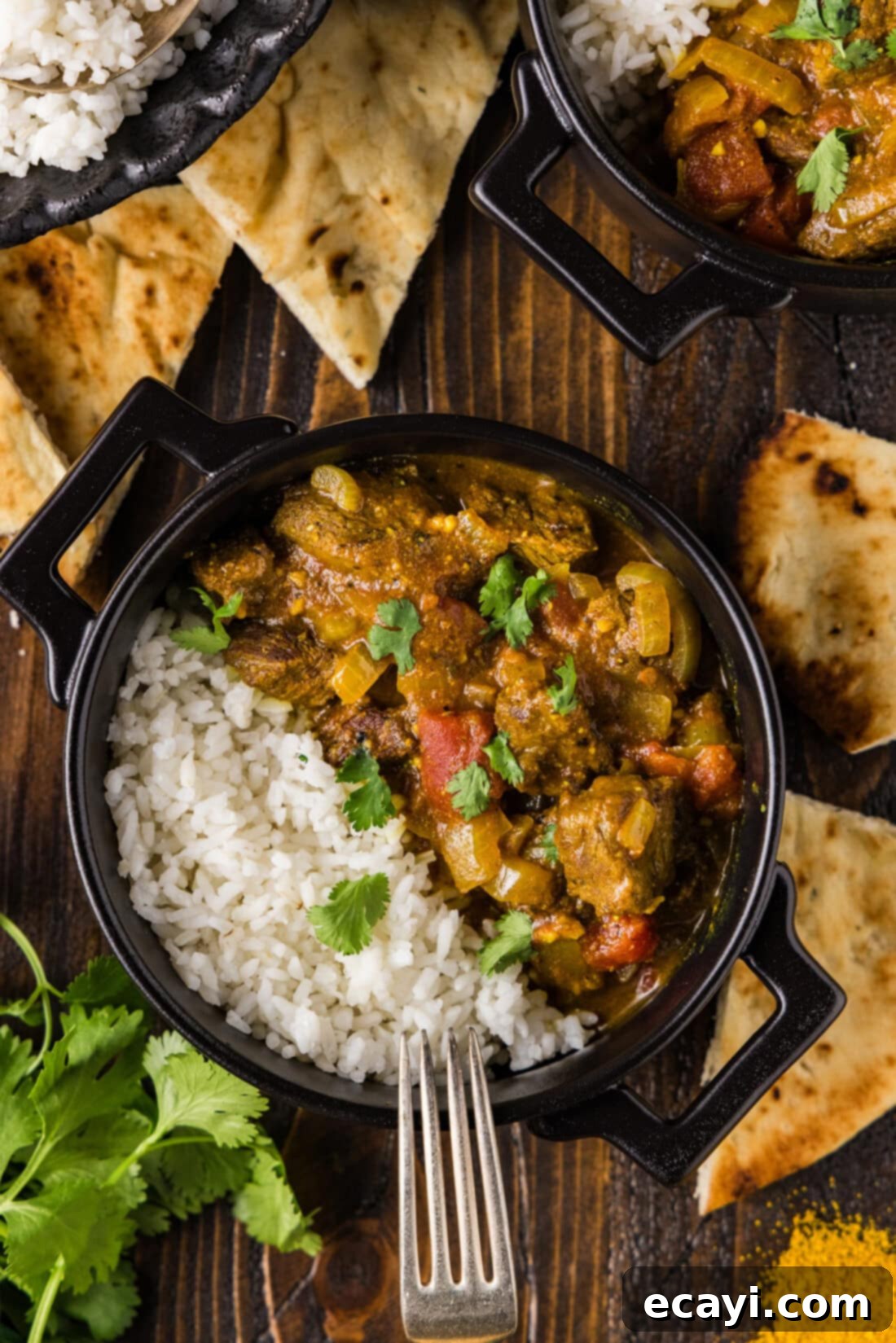
Perfect Serving Suggestions for Your Stovetop Beef Curry
A hearty and aromatic beef curry is a complete meal on its own, but pairing it with the right accompaniments can truly elevate the dining experience. The classic and most beloved pairing is a generous serving of steamy white rice. The rice acts as a perfect canvas, soaking up every drop of the rich, savory sauce, making each bite an absolute delight. Beyond white rice, here are some other fantastic suggestions:
- Naan Bread or Roti: Warm, fluffy flatbreads are ideal for scooping up the tender beef and luscious sauce, adding a wonderful textural contrast.
- Brown Rice or Quinoa: For a slightly healthier and nuttier alternative, these grains provide a satisfying base and additional texture.
- Cauliflower Rice: A popular low-carb option that still effectively absorbs the curry’s delicious flavors.
- Steamed Vegetables: A simple side of lightly steamed green beans, broccoli florets, or fresh spinach can add a refreshing crunch and a nutritional boost.
- Raita: A cooling, yogurt-based condiment often made with cucumber and mint, Raita offers a refreshing contrast to the rich and warm curry.
- Fresh Herbs: A final sprinkle of fresh chopped parsley or cilantro just before serving not only adds a vibrant pop of color but also a burst of fresh, aromatic flavor that brightens the entire dish.
Serve your easy stovetop beef curry warm, garnished optionally with fresh herbs, and get ready to savor the deep, comforting flavors that make this dish so special.
More Delightful Curry & Dinner Recipes to Explore
If you thoroughly enjoyed creating and savoring this easy stovetop beef curry, we encourage you to broaden your culinary horizons with more of our warmly spiced and comforting dinner recipes. Curries are a fantastic way to introduce diverse flavors and exciting cooking techniques into your everyday kitchen. Here are a few other cherished recipes from our collection that you might love:
- Hearty Lentil Curry: A wonderfully satisfying and protein-rich vegetarian option, bursting with flavor.
- Quick Shrimp Curry: A lighter and faster curry alternative, perfect for busy weeknights when you need a delicious meal in a hurry.
- Creamy Chicken Curry: Our ever-popular chicken curry, renowned for its delightful coconut milk base and rich, mellow flavors.
- Classic Chicken Tikka Masala: A universally adored dish featuring succulent chicken in a creamy, spiced tomato sauce that’s hard to resist.
Embarking on an adventure through various curry recipes is a truly delicious way to explore new tastes and expand your cooking repertoire!
I love to bake and cook and share my kitchen experience with all of you! Remembering to come back each day can be tough, that’s why I offer a convenient newsletter every time a new recipe posts. Simply subscribe and start receiving your free daily recipes!
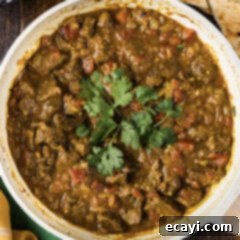
Stovetop Beef Curry
IMPORTANT – There are often Frequently Asked Questions within the blog post that you may find helpful. Simply scroll back up to read them!
Print It
Pin It
Rate It
Save ItSaved!
Ingredients
- 1 ½ pounds beef chuck roast fat trimmed
- ¾ teaspoon black pepper
- 1 ½ teaspoons garlic salt divided
- 2 Tablespoons curry powder divided
- ¼ cup olive oil
- 2 teaspoons minced ginger
- 1 Tablespoon minced garlic
- 1 cup chopped onion
- ¼ cup dry white wine
- 14 ounces canned tomatoes we prefer Fire Roasted
- 3 bay leaves
- ½ cup water
Tools You’ll Need
-
Large mixing bowl
-
Large heavy bottomed skillet or Dutch oven
Before You Begin
- While beef chuck roast is the preferred cut for its exceptional tenderness when slow-cooked, you can also substitute pre-cut beef stew meat. Keep in mind that stew meat might require a slightly longer simmering time to achieve the desired melt-in-your-mouth texture.
- For an even deeper and more robust flavor in your sauce, or if you are opting to omit the white wine, feel free to use beef or vegetable stock instead of water. This simple swap will significantly enrich the overall taste of your curry.
Instructions
-
Trim any excess fat from the beef chuck roast and cut it into uniform bite-sized cubes. Place the cubed beef into a large mixing bowl.1 1/2 pounds beef chuck roast
-
Season the beef generously with ¾ teaspoon of black pepper, ¾ teaspoon of garlic salt (half of the total amount), and 1 Tablespoon of curry powder (half of the total amount). Using clean hands or gloved hands, combine the meat and seasonings thoroughly, ensuring each piece is well-coated.3/4 teaspoon black pepper, 1 1/2 teaspoons garlic salt (divided), 2 Tablespoons curry powder (divided)
-
Heat ¼ cup of olive oil in a large, heavy-bottomed skillet over medium-high heat until it begins to shimmer.1/4 cup olive oil
-
Add the seasoned beef cubes to the hot skillet, making sure not to overcrowd the pan (work in batches if necessary). Cook for about 2 minutes undisturbed to allow a crust to form, then turn the beef over and cook for another minute or so until evenly browned. Remove the seared beef from the skillet and transfer it to a separate bowl, keeping it warm and reserving any juices that collect.
-
Reduce the heat to medium. To the same skillet, add 2 teaspoons of minced ginger, 1 Tablespoon of minced garlic, and 1 cup of chopped onion. Sauté, stirring frequently, until the onions are soft and translucent, typically 2-3 minutes.2 teaspoons minced ginger, 1 Tablespoon minced garlic, 1 cup chopped onion
-
Pour in ¼ cup of dry white wine to deglaze the pan, scraping up any delicious browned bits from the bottom. Add 14 ounces of canned tomatoes, the remaining ¾ teaspoon of garlic salt, 3 bay leaves, the remaining 1 Tablespoon of curry powder, and ½ cup of water. Stir everything well to combine and form the curry base.1/4 cup dry white wine, 14 ounces canned tomatoes, 3 bay leaves, 1/2 cup water
-
Return the reserved seared beef, along with any accumulated juices, back to the skillet. Stir well to ensure the beef is submerged and coated in the sauce. Bring the mixture to a gentle boil over medium heat.
-
Once boiling, reduce the heat to low, cover the pan with a lid, and let it simmer for 20-25 minutes, or until the beef is incredibly tender and easily pulls apart with a fork. Adjust seasoning if needed before serving.
Expert Tips & FAQs
- Store any cooled leftovers in an air-tight container kept in the refrigerator for 3-4 days. Reheat on the stovetop over medium-low heat or in the microwave in short bursts, adding a splash of water or broth if needed to loosen the sauce. This curry often tastes even better the next day!
- For a deeper flavor, consider marinating the beef with the seasonings for at least 30 minutes, or even overnight in the refrigerator, before searing. This allows the spices to deeply penetrate the meat.
- Don’t rush the simmering step. Low and slow heat is key to breaking down the beef’s connective tissues, allowing it to become wonderfully tender while the flavors meld beautifully.
- Always taste your curry before serving. You might want to add a little more salt, black pepper, or even a squeeze of fresh lemon juice to brighten the flavors just before taking it off the heat.
Nutrition Information
The recipes on this blog are tested with a conventional gas oven and gas stovetop. It’s important to note that some ovens, especially as they age, can cook and bake inconsistently. Using an inexpensive oven thermometer can assure you that your oven is truly heating to the proper temperature. If you use a toaster oven or countertop oven, please keep in mind that they may not distribute heat the same as a conventional full sized oven and you may need to adjust your cooking/baking times. In the case of recipes made with a pressure cooker, air fryer, slow cooker, or other appliance, a link to the appliances we use is listed within each respective recipe. For baking recipes where measurements are given by weight, please note that results may not be the same if cups are used instead, and we can’t guarantee success with that method.
